Volcanoes Influence Climate
How Volcanoes Influence Climate Over Shorter Timescales
The gases and dust particles thrown into the atmosphere during volcanic eruptions have an effect on climate. For the most part they cool the planet by shading incoming solar radiation. This affect can last for months to years, depending on the characteristics of the eruption. Eruptions in the tropics can have an effect on the climate of both hemispheres. Volcanic eruptions at mid or high latitudes only have an effect on the hemisphere they are within. Volcanoes have also caused global warming over long geologic time scales when extreme amounts of volcanism occurred.
Particles of dust and ash
Volcanic dust (ash) released into the atmosphere during volcanic causes temporary cooling. Larger particles have little effect because they fall out of the air quickly. Small ash particles in the troposphere form a dark cloud that shades and cools the area directly below. These particles will fall out of the atmosphere in rain a few hours or days after the event. The dust that causes the most cooling is that which gets into the stratosphere. It can stay in the stratosphere for months, blocking sunlight and causing cooling over large areas of the Earth.
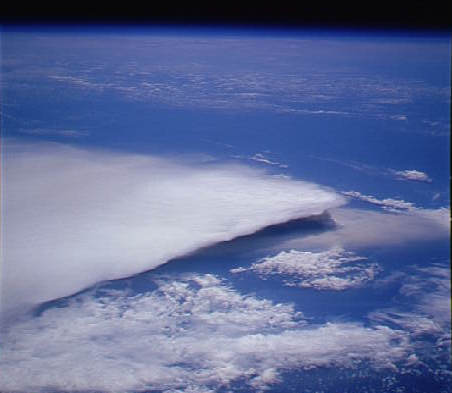
Ash plume from Rabul volcano in Papua New Guinea as seen from the Space Shuttle on 19 September 1994. Credits: NASA
|
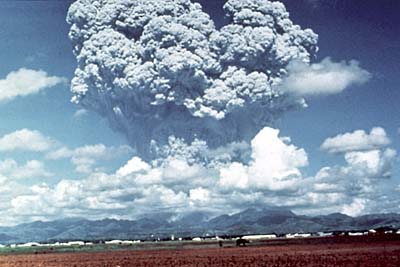
A huge cloud of volcanic ash and gas rises above Mount Pinatubo, Philippines, on June 12, 1991. Three days later, the volcano exploded in the second-largest volcanic eruption on Earth in the 20th century. Credits: USGS
|
Sulfur
Often, erupting volcanoes emit sulfur dioxide into the atmosphere. Sulfur dioxide is much more effective than ash particles at cooling the climate. The sulfur dioxide moves into the stratosphere and combines with water to form sulfuric acid aerosols. The sulfuric acid makes a haze of tiny droplets in the stratosphere that reflects incoming solar radiation. This causes surface cooling. The aerosols can stay in the stratosphere for up to three years, moved around by winds and causing significant cooling worldwide. Eventually, the droplets grow large enough to fall to Earth.
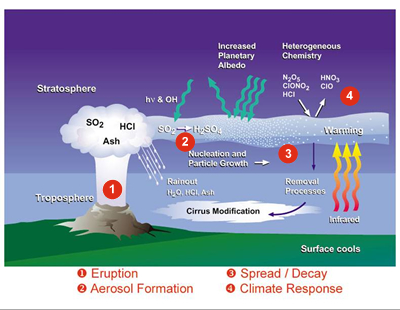
Illustration of production and effect of volcanic aerosols, including SO2. Credits: Windows to the Universe staff (Lisa Gardiner)
|
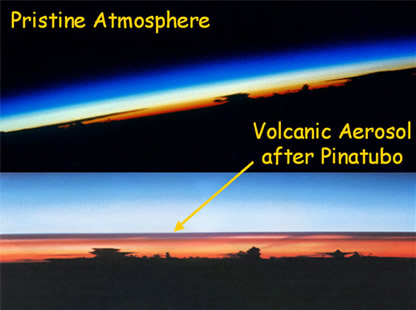
Images from NASA Space Shuttles reveal the presence of volcanic aerosols after the Mount Pinatubo eruption in 1991. Credits: NASA and Caspar Ammann
|
Greenhouse gases
Volcanoes also release large amounts of greenhouse gases water vapor and carbon dioxide. The amounts put into the atmosphere from a large eruption doesn't change the global amounts of these gases very much very much. However, there have been times during Earth history of intense volcanism that significantly increased the amount of carbon dioxide in the atmosphere and caused global warming.
Measuring the Climate Effects of Volcanic Eruptions
Not all volcanic eruptions are the same! The characteristics often depend on the type of magma within a volcano. There are three main indices used to assess the effects of volcanic eruptions on climate. Each is described below.
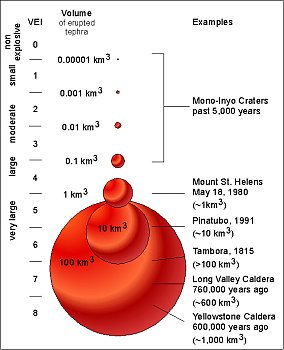
The Volcanic Explosivity Index (VEI).
Credits: USGS
|
- The Level of Atmospheric Perturbation: The Dust Veil Index (DVI) takes into account the amount of material dispersed into the atmosphere and the amount that the material blocks the incoming solar radiation.
- The Eruption Characteristics: Total Mass and Explosiveness: The Volcanic Explosivity Index (VEI) ranks volcanic eruptions to assess magnitude, intensity, dispersion and destructiveness. Eruptions are ranked from 1 to 8 with 8 being the most explosive. Eruptions are more explosive at volcanoes with very viscous magmas rich in silicon, aluminum, and sulfur. The viscous magma blocks the volcano's vents and trapped gases are heated, expand, and build pressure in the plugged vent until explosion. To get exploded material into the stratosphere takes an event with a VEI of at least 4.
- The Sulfur Release and Transport to Poles: Paleo-evidence of volcanic eruptions is recorded in ice sheets by the deposition of sulfuric acid aerosols. Thus, we have a proxy record of eruptions prior to recorded history. The Ice Core Volcanic Index (IVI) use data from ice cores, mainly based on sulfate levels to assess paleo-volcanic eruptions.
|
You might also be interested in:

Looking for online content that can be used for a climate change education course or module? Pages linked below can be used to support an introductory climate change education for either a unit or a full
...more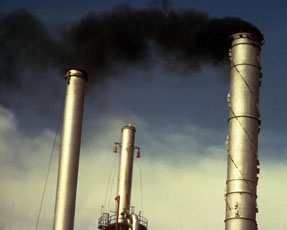
Leaders from 192 nations of the world are trying to make an agreement about how to limit emissions of heat-trapping greenhouse gases, mitigate climate change, and adapt to changing environmental conditions.
...more
Climate in your place on the globe is called regional climate. It is the average weather pattern in a place over more than thirty years, including the variations in seasons. To describe the regional climate
...more
Less than 1% of the gases in Earth's atmosphere are called greenhouse gases. Even though they are not very abundant, these greenhouse gases have a major effect. Carbon dioxide (CO2), water vapor (H2O),
...more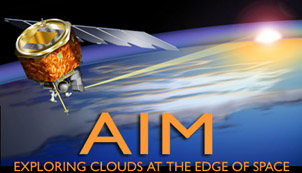
Television weather forecasts in the space age routinely feature satellite views of cloud cover. Cameras and other instruments on spacecraft provide many types of valuable data about Earth's atmosphere
...more
Predicting how our climate will change in the next century or beyond requires tools for assessing how planet responds to change. Global climate models, which are run on some of the world's fastest supercomputers,
...more
The world's surface air temperature increased an average of 0.6° Celsius (1.1°F) during the last century according to the Intergovernmental Panel on Climate Change (IPCC). This may not sound like very
...more



















